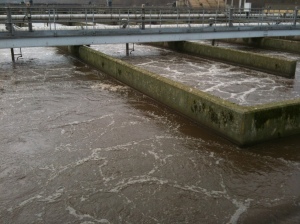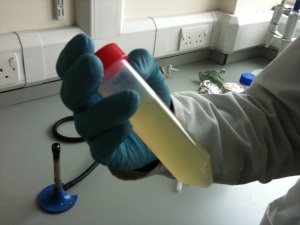
This post relates to a paper I recently published, which you can download here.
Conducting an ethnography of a sewage facility, in the midst of sludge and mud and sewage I found my sociological nous rather tested: what was there to say about water treatment processes that could be remotely interesting? Everything was brown and wet. So it was more than my professional lenses that were steaming. Indeed, the stink permeated every fabric and seemed to coat every surface. The process engineers in the facility have a number of strategies for keeping themselves safe in this perilous space. A lot of these techniques have to do with routine practices of managing their bodies: becoming physically comfortable with the grime (“You get used to it.”), improving their balance when walking on wet mud (“My first fall nearly broke my back, so I was careful after.”), wearing two pairs of gloves and socks, and learning a variety of safety procedures (for climbing ladders and so on). Moreover, the process engineers use a range of scripts, anecdotes and narratives for understanding their relationship with the dirt and grime, which was particularly interesting to me when it involved their understandings of microorganisms.
The vast pools of brown sludge that bubble and threaten to engulf you if you trip are also full of bacteria. Intriguingly, the bacteria are similarly understood in relation to the body and practices of maintaining the body’s boundaries. There is an ambiguity about whether engineers understand their bodies as safely protected and separated out from the bacteria (practices are largely organised around covering and cleaning the body) or become attuned to their relation with the bacteria. This is because the engineers tell stories of immunological adaptation. Their stories often involve anecdotes of visitors getting sick, or of new employees getting used to the bacteria. A new recruit to a facility I visited described how he’d had stomach aches and felt sick on-and-off for the first few weeks of working there. He told me that his body had ‘adapted’ and that he now didn’t get sick from the bacteria. Your immune system, he said, “get’s used to them.” The grime is thus a permanent symbol of the omnipresence of bacteria – there’s no escaping them. Rather than coding the bacteria as simply ‘threatening’ or ‘dangerous’ the engineers ‘adapt’ their bodies and practices in ways that alter their understandings both of their bodies and of the bacteria. In this regard, the ontological status of the engineering body in the waste facility is importantly related to the ontological status of bacteria.
These observations of sewerage facilities formed part of our work on synthetic biology, which also involved observations in microbiology laboratories. In the lab, everything is suddenly white. White walls, white stools, white counters, white powders, white liquids, white equipment. I find myself wearing white lab coats. White gloves at the entrance, white gloves on the counter, white gloves stacked onto shelves three deep and ten across. I get used to the feeling of nitrile gloves. The lab is a place where things have to be clean, so there’s also a noxious smelling alcohol routinely spritzed and wiped across the counters.

Some of the labs are temperature controlled, whereas others are fine at room temperature. Some have distinctive whirring, clicking or screeching noises created by the specialist equipment. But although they differ in important ways, they nonetheless share a significant common feature: they are all organised in order to safely manipulate the microbiological realm. This organisation, however, is ultimately determined not by the deterrence of release of these unique organisms, but by prevention of infiltration of more common species that might contaminate the lab apparatuses and thus ruin experiments. Indeed, in the lab the bacteria are at risk. They are engineered to be easy to manipulate and have thus become more susceptible to being out-competed by ‘natural’ bacteria. Practices in the lab are thus geared primarily around protecting the bacteria from the body. And whilst academic engineers are aware of the dangers of the bacteria with which they work, which are often quite minimal, they are generally most concerned with the dangers that their skin (covered with enzymes), the air (filled with stronger strains) and their equipment pose for their microorganisms. Indeed, the bacteria even look puny – tiny quantities in tiny flasks that are barely visible to the naked eye. This is a wholly different world to that of the sewage plant and the bodies of lab engineers are thus importantly different because of these different relations.
This is an important consideration when examining the governance and regulation of engineered microorganisms and when discussing ‘public’ understandings of this science. We explore these issues through other ethnographic episodes in the paper.
Bacterial cultures: Ontologies of bacteria and engineering expertise at the nexus of synthetic biology and water services, Engineering Studies
You can get the paper here: